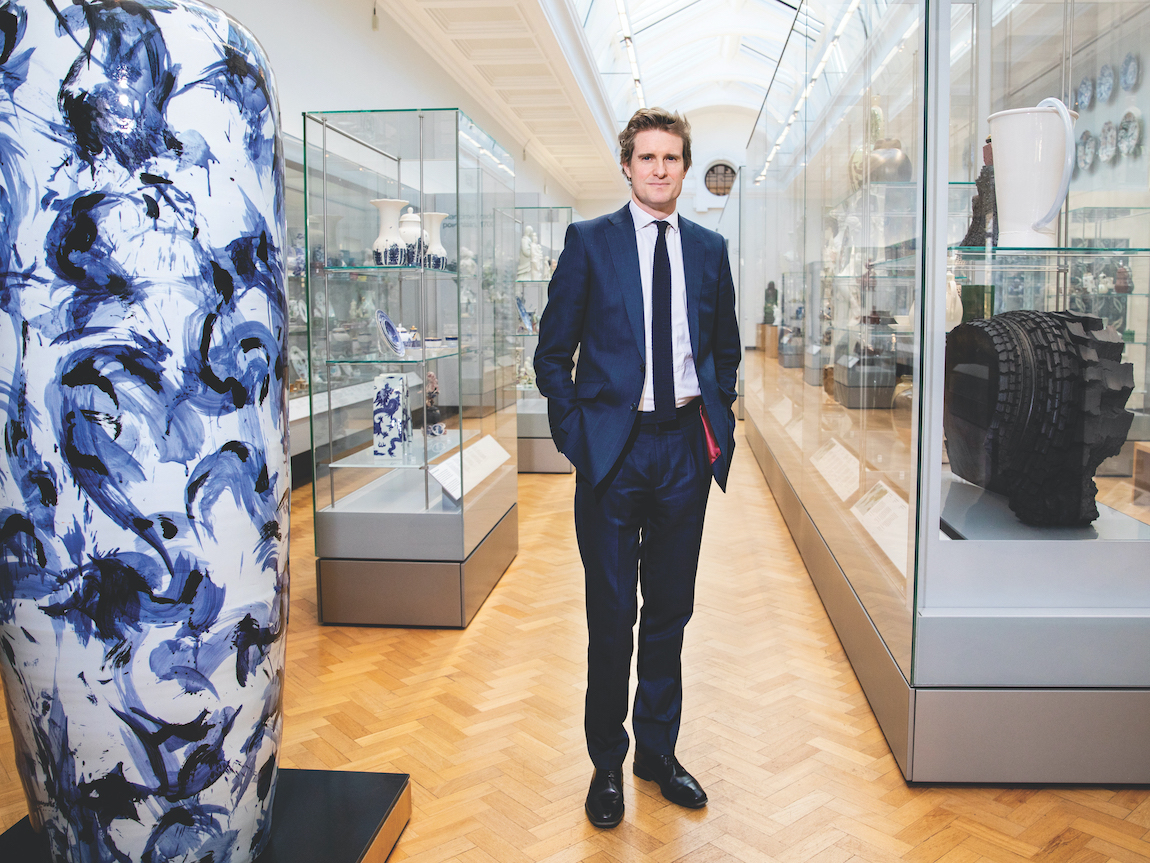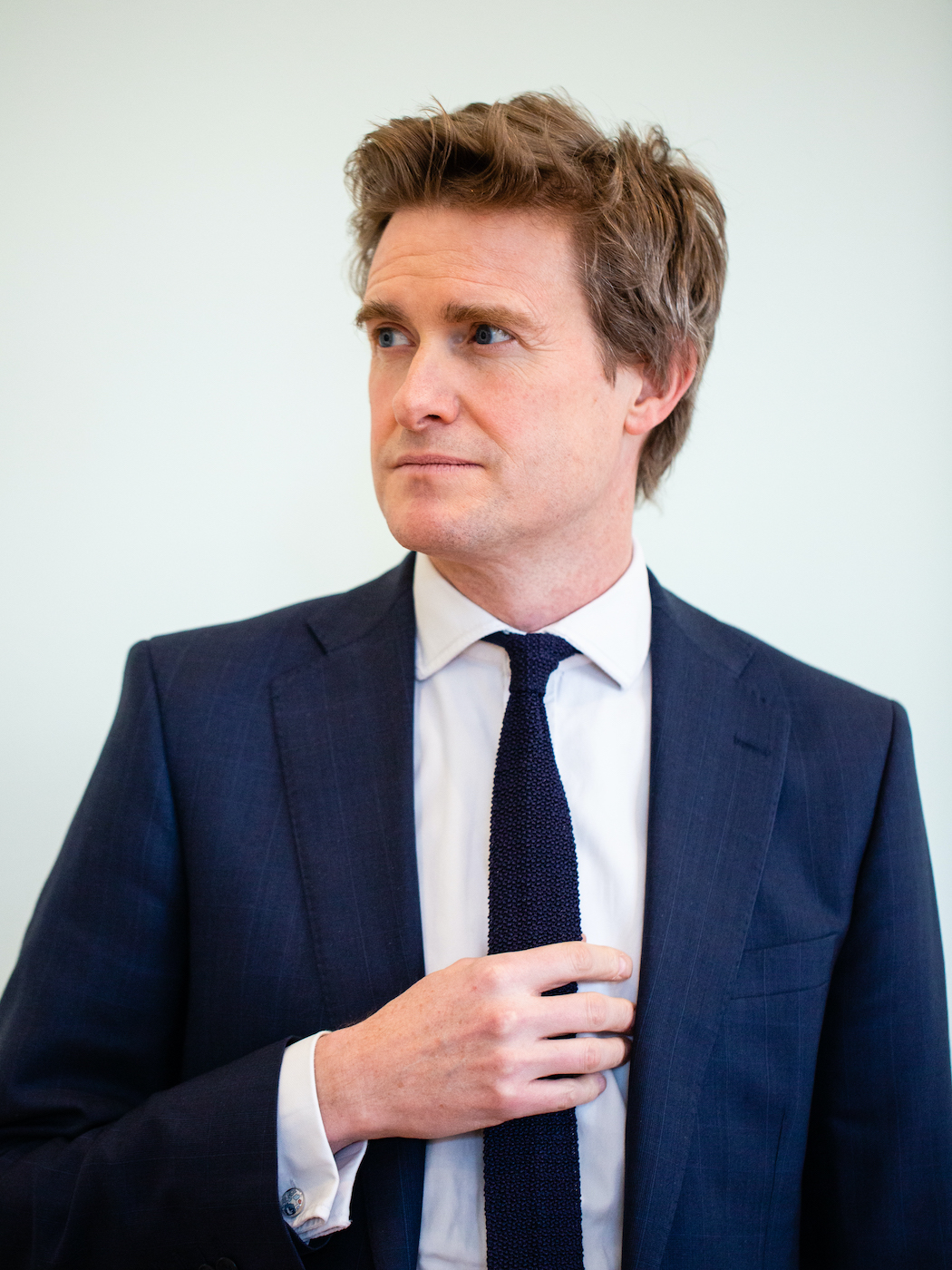The Tristram Hunt interview: "If people want to rewrite a museum label, great!"
Tristram Hunt in the V&A's ceramics gallery. Credit: Louise Haywood Schiefer
10 min read
Director of the Victoria and Albert (V&A) Museum and former Labour MP Tristram Hunt talks to Tali Fraser about rewriting gallery labels, turning off Netflix and the lack of tech billionaire donors.
Photography by Louise Haywood Schiefer
During our interview, V&A director Tristram Hunt has been sitting in front of a wall of blue and white Wedgwood and Minton plates in his office, with a book about Wedgwood ceramics out on his desk – and when we start to walk through the seven miles of museum under Hunt’s jurisdiction, he heads straight for the ceramics gallery to look at more Wedgwood.
If museum directors are allowed favourites – and Hunt insists they are – Wedgwood's copy of the Portland Vase is one of them. Hunt’s face lights up while looking at it: “Isn’t it amazing, with that little figure underneath.” His love of ceramics is one of the lasting ties to the former MP’s constituency in Stoke-on-Trent (Wedgwood’s birthplace), as Hunt, 48, admits: “In all honesty, I wasn’t into ceramics before my time in Stoke!”
Having been made director of the museum in 2017, resigning as an MP in the process, Hunt sees a few similarities with his previous job. “You have got lots of constituents within this organisation, too. We’re 900 people strong, we’ve got a good and engaged board of trustees, brilliant and motivated staff, 60,000 members and a wonderful cohort of volunteers. The job of the director is to set out the strategy and then build the coalitions and listen to colleagues who have been here a lot longer than I have.”
A “big, big part” of his strategy is around improving creative education, especially for state secondary school children, the move to a multi-site V&A by 2025 and “lots of thinking about our colonial and imperial past”. What this thinking will involve appears very much up for debate. As director, he says it involves “being transparent about those histories in those collections and thinking about what happens to them in the future”.
 V&A director Tristram Hunt in the ceramics gallery. Photography by Louise Haywood-Schiefer
V&A director Tristram Hunt in the ceramics gallery. Photography by Louise Haywood-Schiefer
Hunt is not afraid of the debate over public institutions’ modern responsibility; he is enthusiastic. “I think we should be in the debate because it is exciting! If people are excited and challenged and engaged with our collections and the histories they are outlining, that is super interesting. If people want to rewrite a museum label, great!” he says, almost beaming.
Is it really possible, as a member of the general public, to get a label at a national gallery rewritten? Apparently so, he says: “We had someone who had been in the gallery and suggested, and argued very clearly, that one of our labels within the Cast Courts on the Michelangelo cast of Moses allowed for potentially antisemitic tropes. She wrote in, the curators reflected on that, looked at her argument, looked at her source material, and came to the conclusion that she was correct. So we rewrote the label.”
“We’ve had people who find some descriptions of objects objectionable and we won’t rewrite the past but we will ensure that contemporary interpretations are up to date with terminology and how people wish, as it were, their communities to be described. We’re funded by them, it’s their museum,” Hunt clarifies with a grin.
“But” he says, with real emphasis on the “but”, he doesn’t want to “lose focus” of the V&A’s purpose as a home to art, design and performance. “I do sometimes have to remind colleagues that we are not a museum of imperial history or social history or political history. All of those intersect but our line is about art, design and performance. We sometimes have to keep an eye out as we can seek to do almost too much in terms of what is now called the accountability of the objects,” he says with a raised brow. “I think we need to stay in our lane on that. That doesn’t mean to say we’re not engaged with some of the contemporary debates but we shouldn’t lose sight of our primary role.”
That primary role took a knock during the lockdowns. “A museum with no visitors was just, argh,” he says, “after a while of having no one here the objects lose some of this interrelationship that they have with human intrigue.” Walking through the halls, it’s clear how pleased he is to see a steady stream of visitors as Hunt smiles and chats to his volunteers, admiring the people looking at new collections.
“The pandemic was very, very tough,” he says. The museum lost around 14 per cent of its staff, alongside a drop in revenue of £40m and a structural deficit of £10m. They are still feeling the effects now. “Museums, like theatres, concert venues, all of these areas of the experience economy, are feeling the change in the rhythms of life within cities of people working from home and not coming in so often – and we’ve been hit hard by these train strikes, too.”
We agree there has been a loss of spontaneity in post-pandemic London. “There’s a post Covid loss of visiting, partying and enjoying muscle! There is a change in the willingness of people to come out in the way that they used to, we need to turn off Netflix for a month for people to rebuild their strength,” Hunt adds, laughing.
He appears stressed about the year to come, following a period of “very generous government support” during the pandemic. “Going into next year when the Covid support is withdrawn and we have low visitor numbers and a cost of living challenge, next year’s budget is tight and we’re looking at that.” Hunt has previously advocated for a new partnership with government that sees the balance between the museum’s self-generated income and public funding more in line with the European model. Now he, somewhat despondently, bursts into laughter at the suggestion. “That new model is not going to happen. There is no longer the public money for it, so no, my calls have not been realised.”
There is a change in the willingness of people to come out in the way they used to, we need to turn off Netflix for a month
One element of the V&A’s funding issue is concerning their donors. It was part of a network of galleries worldwide that faced protests over their financial ties to the Sackler family, whose philanthropy was linked to the drug at the centre of the opioid crisis. Hunt originally said he was proud of the funding from the American family but in October last year removed the name from its galleries. Now it is modern donors, or lack thereof, presenting an issue as Hunt laments that modern tech billionaires are not taken with the idea of philanthropy in the arts, part of which he suggests is “that thing about new money taking time”.
“It’s not just us. I think museums even on the West Coast of America find this,” he says. “It’s our responsibility. We have to make the case to them that having vibrant, successful cultural institutions is what makes cities attractive, which is where they want to put their personnel and, you know, they’re coming here for a reason.” Hunt laughs when I suggest there could be an Elon Musk wing one day.
He is not the only former politician to have gone into the arts, with former chancellor George Osborne now chair of the British Museum (BM). The pair sometimes find themselves in meetings together. “George,” Hunt says, “has always had a passion and rich understanding of history – and was supportive of various historic sites and liked to have those in his budget.”
One of the biggest questions facing the BM is the fate of the Parthenon Marbles two centuries after they were taken from the ruins of the Parthenon temple in Athens by British nobleman Lord Elgin. “I won’t talk about the Parthenon because it is not done to talk about another museum’s collection,” Hunt says diplomatically. When I ask for his views about the potential of 3D printing, as a perfect replica of a sculpture from the Parthenon Marbles has been carved by robots, cut from the original Greek stone and accurate to a fraction of a millimetre, Hunt is slightly more open.
“We’ve obviously got here the plaster Cast Courts, so having copies of works is a long tradition in museums. People used to call them fakes but they’re not, they are copies and people enjoy them. But people also want to feel this very human sensibility of connection to the original and there’s this wonderful apocryphal poll, actually I think it’s real, of ‘Would you rather go and see an absolutely perfect digital reprint of the Mona Lisa? Or if the Mona Lisa had burned to ashes, would you rather go and see the ashes?’ Everyone is like: ‘I would go and see the ashes’,” he adds, with bemused laughter. The poll Hunt is referencing is actually research by Jesse Prinz and Angelika Seidel, where 80 per cent of respondents chose to see the Mona Lisa’s ashes over a reproduction.
“It’s this old Walter Benjamin idea of the aura of the original – so there are lots of good solutions out there for sharing objects and copying objects, but there’s also something in the human condition, so it’s complicated.”
 V&A director Tristram Hunt. Photography by Louise Haywood-Schiefer
V&A director Tristram Hunt. Photography by Louise Haywood-Schiefer
An added complication is the National Heritage Act, now in its 40th year, which Hunt says “binds trustees and prevents deaccession of items” – and ministers have said it is not going to change, so the V&A has examined alternatives. “What we did with the Istanbul archaeology museum [following the V&A’s long-term cultural partnership loan over the head of Eros] was share conservation techniques and understanding to use these objects as a bridge between peer-to-peer institutions. We have other collections from Ghana and from Ethiopia, where in time we’d like to build similar partnerships.”
Hunt has previously been a great advocate of updating the 1983 National Heritage Act so it works in the current era. “I am still of the same view,” he says. “But ministers have said that it is not on the cards so I have to respect that.” Would he ever go back into politics, so he could make decisions on things like the National Heritage Act himself? “No, no. That period has passed,” Hunt says, looking stressed at the mere suggestion. “I was very, very lucky to be appointed here. I had reached a point of frustration in my political career because of the leadership of the party [under Jeremy Corbyn]. Every day was almost a double negative, because I was opposed to the Conservative government and I was opposed to Jeremy’s leadership of the party.”
“I’ve huge admiration and deep respect particularly for my Labour colleagues who stayed and, in my own terms, fought the good fight. But I had the opportunity of doing something else and doing something productive in these years so I was very, very lucky.” With a large image of Prince Albert – “our hero” – looming over him, Hunt ends: “Even though the V&A is home to 5,000 years of history, it is a very exciting, agile space and I feel very energetic.”
